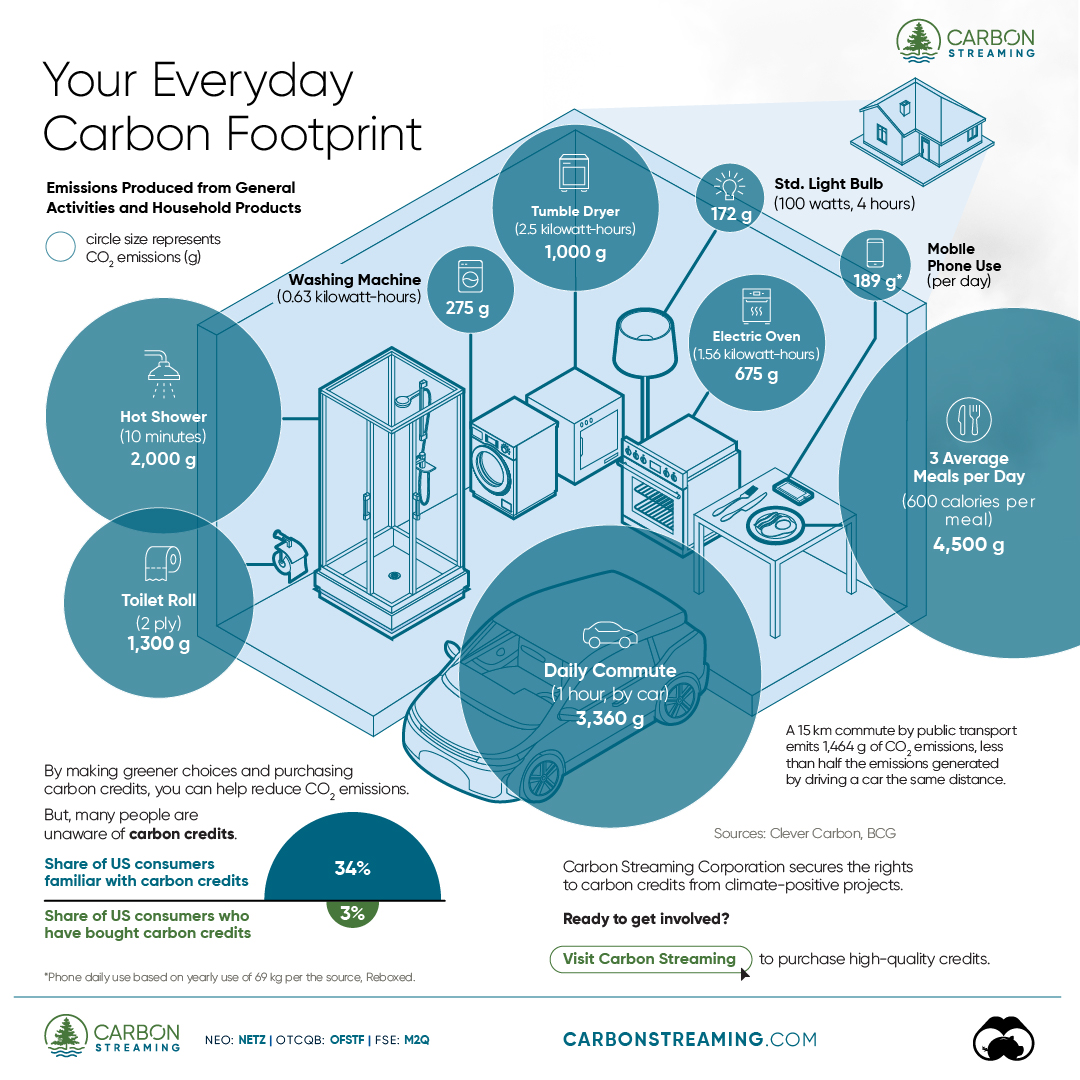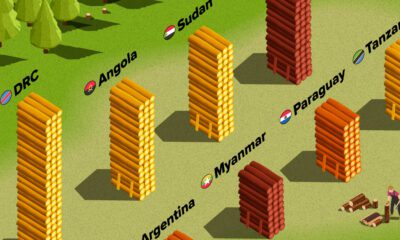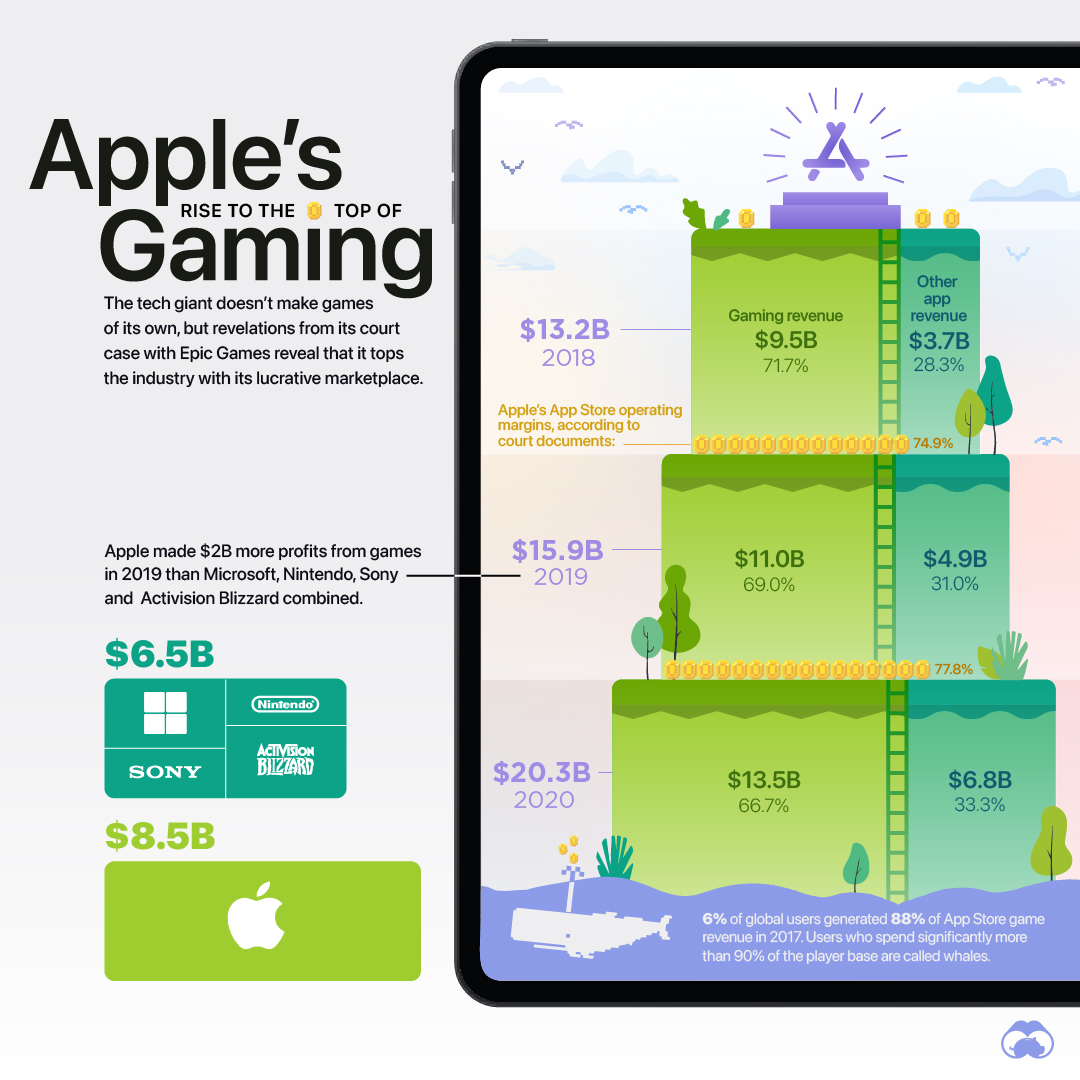Datastream
Visualizing Apple’s Rise to the Top of the Gaming Business

The Briefing
- Apple generates more operating profit from gaming than many of the most reputable gaming companies combined
- Gaming revenues are driven by App Store fees
Visualizing Apple’s Rising Gaming Revenue
In 2020, Apple generated an estimated $13.5 billion dollars in gaming revenue—even though the tech giant doesn’t actually make any games or gaming consoles.
So how does Apple generate all this money from gaming? A key driver of Apple’s gaming revenue is the 30% fee it collects from all app spending, including in-app purchases, subscriptions, and premium app fees.
Through this significant fee structure, Apple has seen its gaming revenue steadily increase over the last few years. Here’s a look at the company’s estimated gaming revenue from 2018 to 2020:
| Year | Apple’s Estimated App Revenue from Gaming | % of Total App Revenue |
|---|---|---|
| 2018 | $9.5B | 71.7% |
| 2019 | $11.0B | 69.0% |
| 2020 | $13.5B | 66.7% |
Note: For fiscal years ending in September
As the data above shows, a majority of Apple’s App Store revenue comes from games. And because of hefty fees, Apple made more profits off of games than some of the most reputable gaming companies who designed them.
For example, in 2019, Apple generated $2 billion more in operating profit than Nintendo, Microsoft, Sony, and Activision Blizzard—combined.
Why Apple’s Dominance is a Problem
The 30% fee is a financial burden for game developers who sell large volumes of in-app purchases. So, in an attempt to bypass Apple’s in-app payment systems, some developers have tried to redirect users to external payment platforms (a competitive tactic called envelopment).
Epic Games tried a version of this by integrating their own payment system into Fortnite. However, Apple then removed Fornite from the App Store, citing violations to the terms of their agreement. In response, Epic Games countered with a lawsuit, accusing Apple of monopolistic practices and antitrust violations.
While Apple ended up winning a majority of the court case, the tech giant was ordered to update their App Store policies, meaning Apple could no longer prohibit gaming companies from directing customers to alternative means of payment.
»>>Like this? Then you might enjoy this article on The History of Gaming, by Revenue Stream
Where does this data come from?
Source: Sensor Tower, via the Wall Street Journal
Datastream
Can You Calculate Your Daily Carbon Footprint?
Discover how the average person’s carbon footprint impacts the environment and learn how carbon credits can offset your carbon footprint.

The Briefing
- A person’s carbon footprint is substantial, with activities such as food consumption creating as much as 4,500 g of CO₂ emissions daily.
- By purchasing carbon credits from Carbon Streaming Corporation, you can offset your own emissions and fund positive climate action.
Your Everyday Carbon Footprint
While many large businesses and countries have committed to net-zero goals, it is essential to acknowledge that your everyday activities also contribute to global emissions.
In this graphic, sponsored by Carbon Streaming Corporation, we will explore how the choices we make and the products we use have a profound impact on our carbon footprint.
Carbon Emissions by Activity
Here are some of the daily activities and products of the average person and their carbon footprint, according to Clever Carbon.
| Household Activities & Products | CO2 Emissions (g) |
|---|---|
| 💡 Standard Light Bulb (100 watts, four hours) | 172 g |
| 📱 Mobile Phone Use (195 minutes per day)* | 189 g |
| 👕 Washing Machine (0.63 kWh) | 275 g |
| 🔥 Electric Oven (1.56 kWh) | 675 g |
| ♨️ Tumble Dryer (2.5 kWh) | 1,000 g |
| 🧻 Toilet Roll (2 ply) | 1,300 g |
| 🚿 Hot Shower (10 mins) | 2,000 g |
| 🚙 Daily Commute (one hour, by car) | 3,360 g |
| 🍽️ Average Daily Food Consumption (three meals of 600 calories) | 4,500 g |
| *Phone use based on yearly use of 69kg per the source, Reboxed | |
Your choice of transportation plays a crucial role in determining your carbon footprint. For instance, a 15 km daily commute to work on public transport generates an average of 1,464 g of CO₂ emissions. Compared to 3,360 g—twice the volume for a journey the same length by car.
By opting for more sustainable modes of transport, such as cycling, walking, or public transportation, you can significantly reduce your carbon footprint.
Addressing Your Carbon Footprint
One way to compensate for your emissions is by purchasing high-quality carbon credits.
Carbon credits are used to help fund projects that avoid, reduce or remove CO₂ emissions. This includes nature-based solutions such as reforestation and improved forest management, or technology-based solutions such as the production of biochar and carbon capture and storage (CCS).
While carbon credits offer a potential solution for individuals to help reduce global emissions, public awareness remains a significant challenge. A BCG-Patch survey revealed that only 34% of U.S. consumers are familiar with carbon credits, and only 3% have purchased them in the past.
About Carbon Streaming
By financing the creation or expansion of carbon projects, Carbon Streaming Corporation secures the rights to future carbon credits generated by these sustainable projects. You can then purchase these carbon credits to help fund climate solutions around the world and compensate for your own emissions.
Ready to get involved?
>> Learn more about purchasing carbon credits at Carbon Streaming
-

 Maps2 weeks ago
Maps2 weeks agoMapped: Average Wages Across Europe
-

 Money1 week ago
Money1 week agoWhich States Have the Highest Minimum Wage in America?
-

 Real Estate1 week ago
Real Estate1 week agoRanked: The Most Valuable Housing Markets in America
-

 Markets1 week ago
Markets1 week agoCharted: Big Four Market Share by S&P 500 Audits
-

 AI1 week ago
AI1 week agoThe Stock Performance of U.S. Chipmakers So Far in 2024
-

 Automotive1 week ago
Automotive1 week agoAlmost Every EV Stock is Down After Q1 2024
-

 Money2 weeks ago
Money2 weeks agoWhere Does One U.S. Tax Dollar Go?
-

 Green2 weeks ago
Green2 weeks agoRanked: Top Countries by Total Forest Loss Since 2001
















